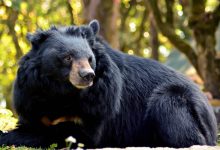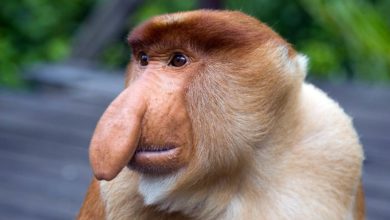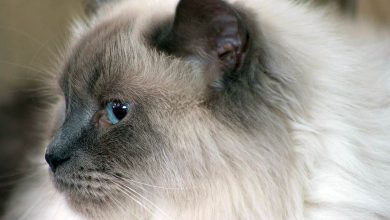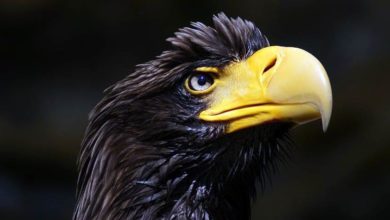Sumatran rhinoceros (Dicerorhinus sumatrensis)
Indonesian loner which loves talking. Although it is the smallest of all rhinos, certainly no less surprising than its larger cousins. Let’s meet the Sumatran rhinoceros closer – the owner of the delicate skin.
Classification
- Kingdom: Animalia
- Class: Mammalia
- Order: Perissodactyla
- Family: Rhinocerotidae
- Genus: Dicerorhinus
- Species: Dicerorhinus sumatrensis
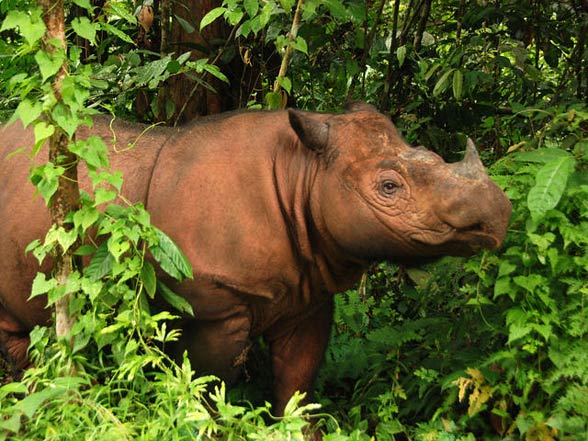
There are three subspecies within the species:
Dicerorhinus sumatrensis lasiotis called Northern Sumatran rhinoceros
It appeared on the area of India and Bangladesh. In both of these countries, it was considered the extinct species. Unverified notifications suggest that small population could survive in Burma but the political situation of the country makes it impossible to verify it. The name ‘lasioti’ comes from the Greek word which means ‘hairy ears’. Later observations showed that hair on ears is not longer than that of other subspecies. The name is rather associated with the fact that the north Sumatran rhinoceros was the biggest representative of the species.
Dicerorhinus sumatrensis sumatrensis called Western Sumatran rhinoceros
Its population includes only 170-230 species staying mainly in Sumatran national parks Bukit Barisan Selatan and Leuser; around 75 species can also reside on Malaysian Peninsula. The main danger for the survival of these species is the loss of the habitat and poaching.
Dicerorhinus sumatrensis harrissoni called Eastern Sumatran rhinoceros or Bornean rhinoceros
It is estimated that the total population is 50 species. It is known for sure that it lives in Sabah- a Malaysian state located in north-east part of Borneo island and camera recordings as well as traps confirmed its presence in West Borneo. However, it has not been confirmed that these animals live in Sarawak state. It has got this name thanks to a zoologist and an anthropologist, Thomas Harrison who worked in Borneo in the 1960s. In comparison with other subspecies, Bornean rhinoceros is much smaller.
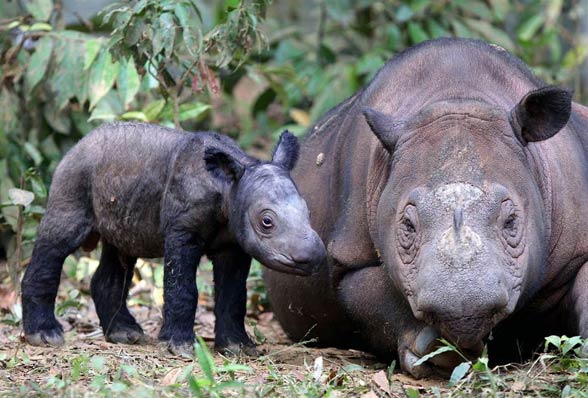
Habitat
It exists in lowland as well as highland rainforests, marshes and so called cloud forests. It stays on hilly areas situated near water.
Characteristics
Appearance
Adult species are 120-145 cm (47-57 in) high at shoulders, around 250 cm (98 in) long and weigh from 500 to 800 kg (1102 to 1764 lb) although the biggest specimen in captivity could weigh around 2 tons (4,400 lb). Similarly to African species, the Sumatran rhinoceros has two horns on the foreface; the bigger one is nearer the nose and it is around 15-25 cm (5.9-9.8 in) long. The back horn is usually much shorter and reaches less than 10 cm (3.9 in) and looks like a bump. Although males usually have longer horns than females, the gender dimorphism is not observed.
On front and hind legs, you can see double skin folds. The smaller fold of skin is also seen on the neck. Nonetheless, the skin is thin- within 16 mm thickness. It also seems that wild species have less subcutaneous fat.
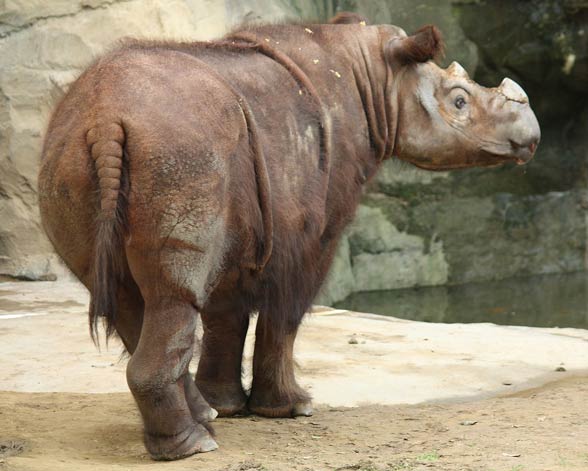
Hair
Sumatran rhinoceros has got quite a lot of hair ( the thickest hair belong to calves) but its hair is not very imposing in most cases. Its marking is reddish-brown; though, it is hard to observe the rhino’s fur in natural habitat as it is covered in mud most of the time. However, zoo species can boast shaggy hair because of less abrasion. The longest hair is situated in ears and at the end of the tail.
As all other rhinoceros, the Sumatran rhinoceros has got weaker sight but it is fast and agile and that is why it climbs steep hills and river banks without problems.
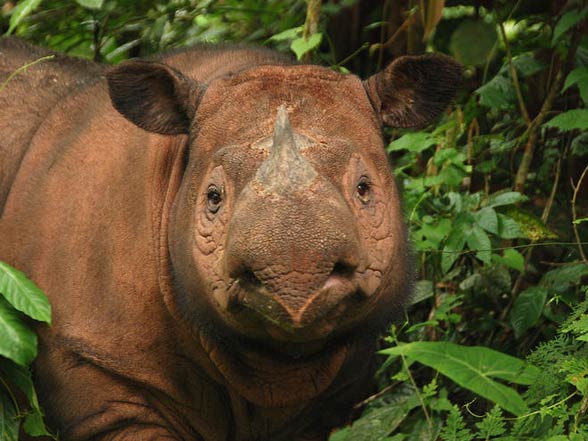
Diet
It usually scavenges at the twilight and after the sun rise. It likes leaves from young bushes, fruit, branchlets and sprouts most; it even eats 50 kilos (22 lb) of plants daily. On the basis of its dung samples, it has been found out that the Sumatran rhinoceros consumes more than 100 plant species. The part of the diet is young trees whose trunks have the diameter of 1-6 cm (0.39-2.36 in). The rhinoceros pushes them over with its body to reach for leaves. A lot of plant species are consumed in little amounts which means it changes the diet and the feeding ground very often. But it is known that it eats Eugenia in a very eager way.
The diet of the Sumatran rhinoceros is high in fiber but moderate in protein. Salt licks are very important (most often hot springs or hot mud-volcanoes) not only if we take into consideration its health but also the social communication. Thanks to the scent left by the previous animal, the rhinoceros using the same salt lick is able to identify the scent of the rival or the female ready for the coupling. Nonetheless, on some areas of rhino’s distribution, it is really hard to find the salt licks and that is why it is possible that species from these areas get valued minerals from consumed plants which are rich in nutrients.

Communication
The Sumatran rhinoceros is very talkative among all rhinoceros species. Even species living in zoos emit a lot of sounds almost all the time. Some of them are really similar to the sounds of the whale e.g. the humpback whale.
The second group of vocalization is combining the whistle-blow and ‘ the explosion’ of the air- it is the loudest sound emitted by the Sumatran rhinoceros- its strength is so big that it makes the metal poles vibrate.
The aims of this vocalization has not been found out but it is assumed that they can warn against the danger, inform about being ready to copulate or about the place of stay. The characteristic whistle-blow resembles the vocalization of elephants, it can be heard at long distances, even up to around 9 km (5.6 mi) (even in thick forests). These species often twist the saplings but they do not eat their leaves. This behavior is considered to be the form of communication with other species and thanks to it, the junction of the trail is indicated.
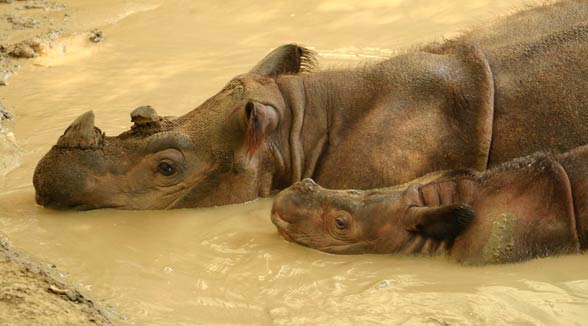
Behaviour
During the year, it prefers to be solitary but the exception is the mating period and taking care of the offspring. Males have bigger ranges than females; what is more, the ranges of females are far away from each other while males’ ranges are very close to each other. It is hard to state whether they defend their areas fighting but it is known they scrape off the bark from trees, twist off the saplings in characteristic patterns and leave droppings.
Its biggest activity is while scavenging at the dawn and after the dusk. It spends the day having soothing mud baths and relaxing. During the rain period, it moves to the higher areas and during colder months, it goes back to the lower ones.
When the mud pool is not available, the rhinoceros deepens puddles using its legs and horns. Wallowing in the mud helps it to regulate the temperature of its body and protects it against insects and ectoparasites. Species living in captivity having no possibility to use mud baths , often suffer from suppurations, eye or nail problems and hair loss. All these problems cause the death of these animals.
The Sumatran rhinoceros living free takes a bath for 2-3 hours before scavenging; but rhinoceros staying in zoos wallow for about 45 minutes a day.
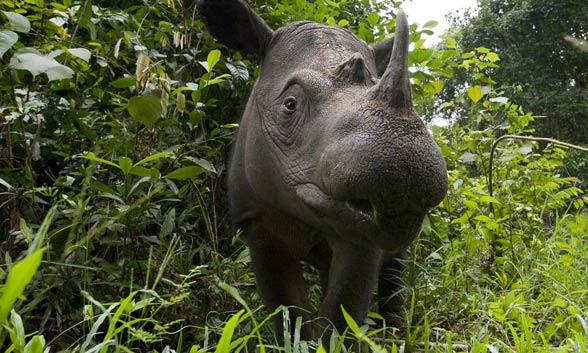
Natural enemies
The Sumatran rhinoceros do not have many natural enemies. Its biggest danger are people, tigers and wild dogs which are able to kill the calf. The young always stay close to their mother so we do not know what the frequency is for such attacks.
Although the areas where the rhinos exist are the same as those of elephants and tapirs, the competition of interspecies has not been observed. What is more, the trails of Indian elephants and the Sumatran rhinoceros are common to a large extent and those trails made by elephants and rhinoceros are used by roes, boars and wild dogs. Trails are divided into those between salt licks which are used by all generations or ‘corridors’ leading through inhospitable areas. On the feeding ground, there are less footworn firebreaks.
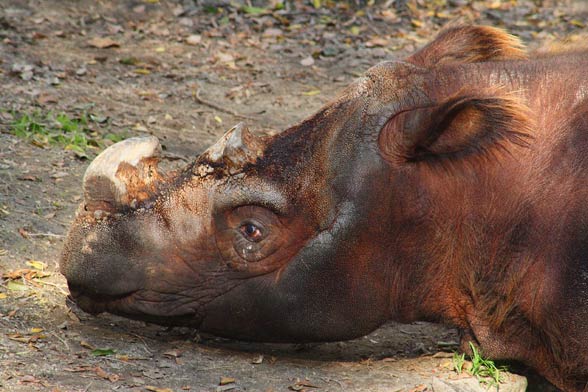
Reproduction
Females reach sexual maturity between 6 and 7 years old, but males need for that about 10 years. Ways of advances are known only from captive specimens. During this period, vocalization is increased, animals rise their tails more often, urinate and the physical contact is increased especially with their heads and genitals.
The pattern of courtship resembles most the one of the black rhinoceros. Young males of the Sumatran rhinoceros are often very aggressive towards females – sometimes they hurt them badly or even kill them. In the wild a threatened female could simply escape, but in captivity this is not feasible. Maybe similar behaviors of these mammals have an impact on the low reproductive success in zoos.
Oestrus lasts about 24 hours and comes in cycles every 21-25 days.
The pregnancy lasts about 15-16 months and after it, there comes one calf who is 40-60 kilos (88-132 lb). The mother breeds it with milk for about 15 months but it stays with the female for 2-3 years. Next time, the female can become pregnant in about 4-5 years.
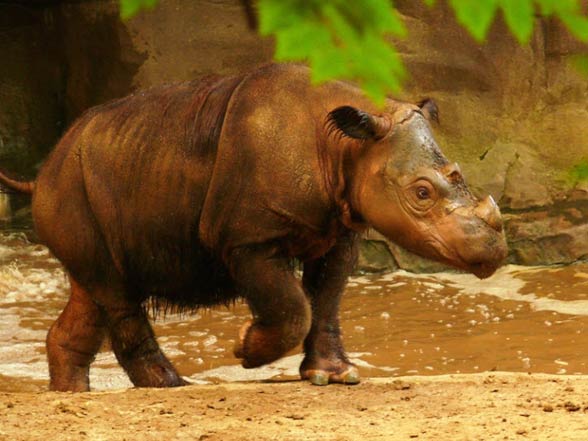
The smallest rhinoceros in the world
The Sumatran rhinoceros is the smallest rhinos in the world among all currently living rhinos.
Detailed information and size:
The Sumatran rhinoceros (Dicerorhinus sumatrensis)
- Body length: 2.36–3.2 m (7ft 9in–10ft 6in), average about 2.5 cm (8ft 2in)
- Height at shoulders: 120-145 cm (3ft 11in-4ft 9in)
- Weight: 500 to 1,000 kg (1,100 to 2,200 lb), average: 500-800 kg (1,100-1,760 lb); the biggest rhino in captivity weighed 2 tons (4,400 lb)
- The length of the bigger horn: 15-25 cm (5.9-9.8 in)
- The length of the smaller horn: below 10 cm (3.9 in)
- The length of the tail: 35-70 cm (14-28 in)
- Lifespan: 30-45 years in the wild, the Sumatran rhinoceros living the longest in captivity was 32 years and 8 months old (a female from the extinct species D. s. lasiotis). It died in London zoo in 1900.
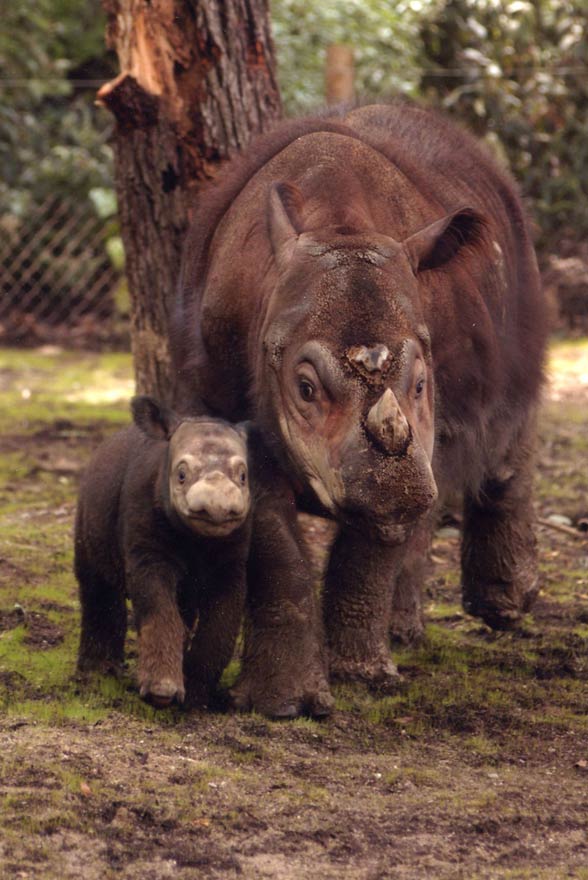
The Sumatran rhinoceros – curios:
- The name Dicerorhinus is derived from the Greek word di – ‘two’ + cero – ‘the horn’. The word sumetrensis is simply ‘Sumatra’ – the name of Indonesian island where the species was discovered.
- The Sumatran rhinoceros is the smallest species of the rhinos in the world.
- Earlier, rhinoceros from Malaysian Peninsula were regarded distinct species – D. s. niger but as time went by, they were incorporated in the D. s. sumatrensis subspecies.
- The longest registered horn was over 81 cm (32 in).
- The Sumatran rhinoceros uses vocalizations most often of all species of rhinos in the world.
- The species is prone to the disease called surra which develops through the kinetoplastid protozoan called trypanosomatida. They are moved around by trumps from Tabanidae family. In 2004, five rhinoceros died 18 days after having been infected.
- Before the extinction, at least 7 rhinoceros from lasiotis subspecies lived in zoos and circus.
- One of the biggest dangers for the survival of these species is poaching caused by the desire to obtain horns whose price is about 30.000 dollars per kilo on the black market (dried meat is also very important as it is used as a cure for diarrhea, leprosy and tuberculosis). The important cause of the critical extinction is the law which was introduced after the devastating tsunami.
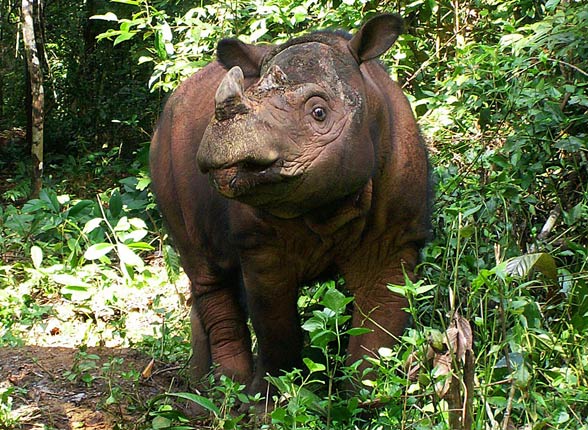
Recommended
- Rhinos
- Woolly rhinoceros
- Arsinoitherium
- Elasmotherium
- Animals & dinosaurs records
- The fastest animals – Top 100
- The fastest birds – Top 10
- The heaviest dinosaurs – Top 10
- The longest dinosaurs. Sauropods Top 10
- The longest predatory dinosaurs. Theropods Top 10
- The heavies predatory dinosaurs Top 10
- The longest and largest ornithopods
- The longest and largest ceratopsians
- The shortest sauropods
- The smallest dinosaurs – Top 10


